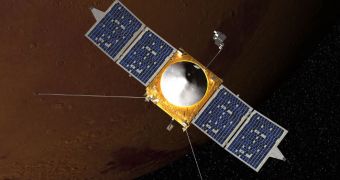Officials at the American space agency announce that the next mission to Mars has successfully completed the Mission Critical Design Review (CDR), an important milestone in its development.
NASA is currently building the Mars Atmosphere and Volatile EvolutioN (MAVEN) spacecraft, which it plans to launch to the Red Planet in 2013. The goal of the flight will be to make more sense of the behavior the Martian upper atmosphere is exhibiting.
Particularly, experts have a hard time figuring out where all the methane around the planet is coming from. Physicists have shown that the atmosphere is losing some of the gas, but supplies appear to be constantly refreshed from an yet-unknown source.
MAVEN is being built to clear up this mystery. Together with the upcoming Trace Gas Orbiter (TGO), the spacecraft will provide a comprehensive view of the chemical reactions occurring high above the Martian surface.
Understanding our neighboring planet's climate evolution is essential for figuring out whether it was ever capable of supporting life or not. Data provided by the Phoenix Mars Lander and the twin Mars Exploration Rovers appears to indicate that that was indeed the case.
The upcoming mission will have to keep track of all gases escaping the atmosphere, determine the velocity at which this happens, the rate of loss and replenishment and other such traits. These data will then be fed in a computer model.
Experts believe that the simulation will then allow them more insight into the mysterious nature of the Martian atmosphere. However, before any of this can be done, NASA needs to construct the actual spacecraft, and test it thoroughly.
“It is a real pleasure to see the MAVEN team is doing an exemplary job on this important mission, which was identified as a top priority mission in the 2002 National Research Council Decadal Survey and addresses high-priority goals of two Divisions – Planetary Sciences and Heliophysics,” sys Michael Meyer.
The expert holds an appointment as the lead scientist for the NASA Mars Exploration Program, at the agency's Headquarters, in Washington DC. “Understanding how and why the atmosphere changed through time is an important scientific objective for Mars,” adds Bruce Jakosky.
“MAVEN will make the right measurements to allow us to answer this question. We’re in the middle of the hard work right now – building the instruments and spacecraft – and we’re incredibly excited about the science results we’re going to get from the mission,” he continues.
Jakosky is the principal investigator for the MAVEN mission. He is based at the University of Colorado Laboratory for Atmospheric and Space Physics (CU/LASP), in Boulder, Colorado.

 14 DAY TRIAL //
14 DAY TRIAL //